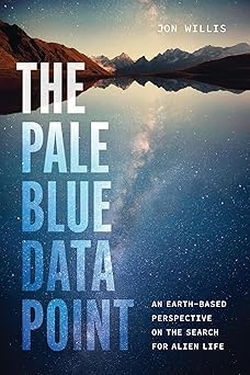Centauri Dreams
Imagining and Planning Interstellar Exploration
A Supernova Link to Ancient Wildfires?
Did huge fires several million years ago force a transition from forest to savanna in northeast Africa? It’s a tantalizing thought, as such fires have been seen as a possible factor in driving the emergence of bipedalism in our remote ancestors. Adrian Melott (University of Kansas), who looks at the question in a new paper in the Journal of Geology, notes that our precursors would have adapted to such massive changes to their habitat, evolving to support life amidst the abundant grasslands that had replaced their former tree-filled environments.
The conjecture about early hominins is receiving a lot of attention, but it plays only a small role in this paper, which focuses on the linkage between supernovae activity and the period in question. Just how do we make the call on a nearby supernova? Melott has been studying the question for some time, and refers back to 2016 studies of ancient seabed deposits of iron-60 isotopes that appeared in Nature. At that time, two supernovae events, one from 1.7 to 3.2 million years ago, the other from 6.5 to 8.7 million years ago, were identified via iron-60 deposits.
The new study points to the accumulating evidence for supernovae in the vicinity of the Earth, finding the strongest signal at 2.6 million years, and notes that this may represent a series of supernovae beginning as far back as 7 million years that Melott relates to the clearing out of the Local Bubble, which is a cavity in the interstellar medium in the Orion Arm in which our own Local Interstellar Cloud is located. Supernovae are thought to have emptied this cavity.
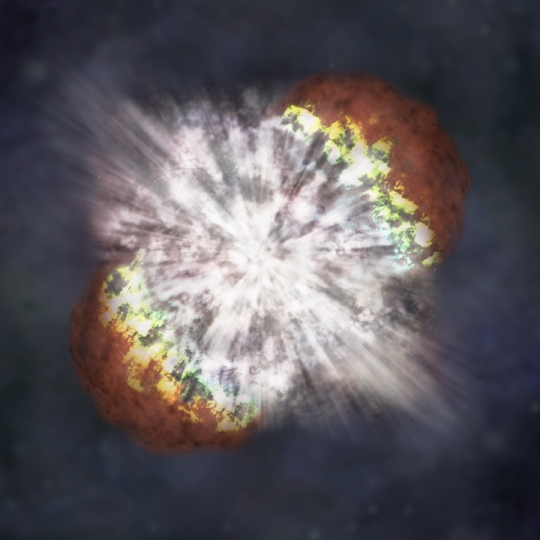
Image: Supernovae bombarded Earth with cosmic energy starting as many as 8 million years ago, with a peak some 2.6 million years ago, initiating an avalanche of electrons in the lower atmosphere and setting off a chain of events that conceivably ended with bipedal hominins such as homo habilis. Credit: NASA.
In the paper, Melott and colleague Brian Thomas (Washburn University) assume a supernova occurring 2.6 million years ago at a distance of 50 parsecs, or 163 light years, a time after the Local Bubble had already formed. The authors compute the extent of cosmic ray propagation and consider effects on terrestrial life, with particular regard to muons, the highly penetrating elementary particles that are the primary component of cosmic ray irradiation at the surface.
A key result is increased ionization of the atmosphere as a result of supernovae cosmic rays, with ‘electron avalanches’ set off that are the primary initiator of lightning (a still controversial idea, though one the authors cite recent evidence to support). From the paper:
A 50 times increase in atmospheric ionization in the troposphere would clearly make the breakdown and electron cascade much easier, and one could expect a great increase in lightning (e.g. Erlykin and Wolfendale, 2010). Furthermore, the originally isotropic distribution of cosmic rays would result in showers which are much more preferentially vertical, due to the variation in atmospheric column density with angle. So, not only would lightning be enhanced, but cloud-to-ground lightning should be preferentially enhanced. The theory of lightning initiation is not well-developed, and we cannot say that a 50-fold increase in ionization would lead to a 50-fold increase in the number of lightning events. However, the potential is there for a large increase.
As the paper notes, lightning is the main initiator of wildfires (excluding humans), and an increase in lightning strikes would be expected to induce large numbers of wildfires. The conversion of forest to savanna, a worldwide phenomenon beginning about 7 million years ago, may have been caused by the increase in wildfires associated with this period, as found in soot and other carbon-related sediments. Thus the notion, not emphasized in the paper, that supernovae could have played a role in human evolution. Here’s Melott on the matter:
“The observation is that there’s a lot more charcoal and soot in the world starting a few million years ago. It’s all over the place, and nobody has any explanation for why it would have happened all over the world in different climate zones. This could be an explanation. That increase in fires is thought to have stimulated the transition from woodland to savanna in a lot of places — where you had forests, now you had mostly open grassland with shrubby things here and there. That’s thought to be related to human evolution in northeast Africa. Specifically, in the Great Rift Valley where you get all these hominin fossils.”
Supernovae are not frozen in time, so the logical question is whether events like these could occur in our future. A possible future Type II supernova (resulting from the collapse of a massive star and subsequent explosion) can be found in Betelgeuse, which may light up the skies sometime in the next million years, according to current estimates. But at 200 parsecs, it is not likely to cause major consequences. Melott and Thomas see solar events as far more concerning as we consider solar flares in the context of our technological civilization.
The paper is Melott and Thomas, “From cosmic explosions to terrestrial fires?” published online by the Journal of Geology 28 May 2019. Abstract / Preprint.

Explaining Luna’s Farside
The Moon’s farside used to be a convenient setting for wondrous things. After all, no one had ever seen it, setting the imagination free to insert everything from paradisaical getaways (think Shangri-La in space) to secret technologies or alien civilizations. The Soviet Luna 3 image of 1959 took the bloom off that particular rose, but we also learned through this and subsequent missions that farside really does have its differences from the familiar face we see. More craters, for one thing, and fewer of the dark plains we call maria, or ‘seas.’
We can throw in measurements made by the GRAIL mission (the Gravity Recovery and Interior Laboratory) in 2012. GRAIL was a NASA Discovery-class mission that performed gravitational field mapping of the Moon as a way of examining its internal structure, a set of two probes that worked by analyzing measured changes in distance between the two craft as small as one micron. We wound up with a map of our satellite’s gravitational field that led to deeper understanding of its crust, its thermal evolution and its subsurface structure.
Here again we find variation between farside and what we see from Earth. The Moon’s crust is thicker and contains an additional layer on farside. In fact, the farside crust is on the order of 20 kilometers thicker than nearside, and GRAIL’s remote sensing data tell us that this extra crustal material is composed of silicate minerals, magmas, and rocks which are relatively high in the heavier elements. A collision between a dwarf planet and the Moon that occurred after the Moon had already formed a solid crust is now emerging as one explanation for these differences.
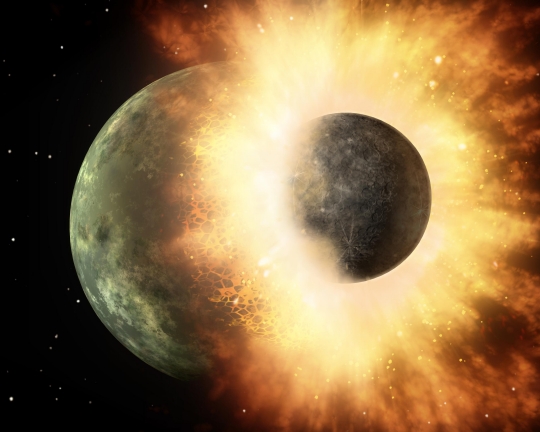
Image: Artist’s depiction of a collision between two planetary bodies. New research suggests the stark difference between the Moon’s heavily-cratered farside and the lower-lying open basins of the nearside were caused by a wayward dwarf planet colliding with the Moon in the early history of the solar system. Credit: NASA/JPL-Caltech.
The research presenting the theory is being led by Meng Hua Zhu of the Space Science Institute at Macau University of Science and Technology. Zhu and colleagues are using GRAIL data as fodder for computer simulations that work through impact scenarios for the early Moon, some 360 of them, to see whether they can reproduce the crustal variation we see today.
The work has produced a model that fits the bill, involving the impact of an object a bit smaller than Ceres (780 kilometers in diameter) striking the Moon’s nearside at 22,500 kilometers per hour. A second fit to the data is a smaller (720 kilometer) object hitting at 24,500 kilometers per hour. In both cases, material blown off the surface would fall back to bury the farside crust in kilometers of debris, which fits the additional crust layer found by the GRAIL mission.
Wouldn’t we see evidence on the nearside of such a titanic collision? Depending on conditions in the early Moon, the telltale signs may be hard to tease out, but the authors believe their model can explain the farside highlands and the nearside lowlands, noting such nearside features as “a large area of low-Ca pyroxene on the nearside observed by Kaguya mission that was explained to be formed via impact through melting a mixture of crust and mantle materials.” Let me quote more from the paper on this, talking about the formation of a ‘mega basin’ covering most of nearside:
…the mega basin structure may not be the same to the surface expression of a typical basin formed later. It is likely that the morphologies of mega basin were heavily modified and possibly even erased due to high internal temperature of the early Moon (Miljkovic et al., 2017), which easily allowed for isostatic relaxation processes (Freed et al., 2014). Therefore, it is highly possible that remnants of a giant impact on the early Moon may be less pronounced and significantly different from the impact basins formed later. To test whether a giant impact on the nearside is a plausible mechanism for the formation of Moon’s asymmetries, we performed a systematic numerical modeling study and quantified the outcome of such impact events.
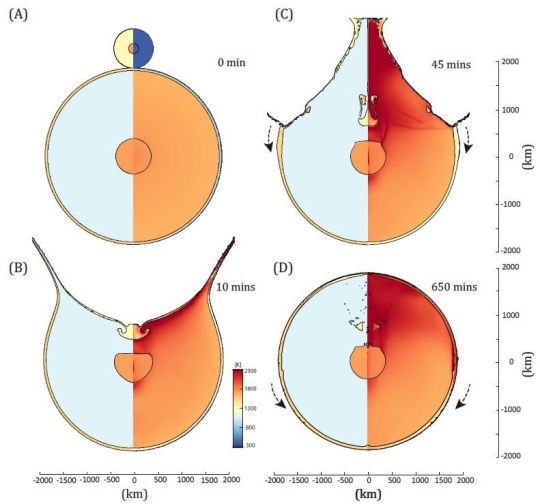
Image: The basin-forming process for an impactor 780 kilometers in diameter (with a 200-kilometer diameter of iron core) with an impact velocity of 22,500 kph (14,000 miles per hour). In each panel, the left halves represent the materials used in the model: gabbroic anorthosite (pale green), dunite (blue), and iron (orange) represent the lunar crust, mantle, and core, respectively. The gabbroic anorthosite (pale yellow) also represents the impactor material. The right halves represent the temperature variation during the impact process. The arrows in (C) and (D) represent the local materials that were moved and formed the new crust together with deposits of material that was blasted from the impact. Credit: JGR: Planets/Zhu et al. 2019/AGU.
Simulating the impact scenarios produces variation in post-impact ejecta and crustal thickness that can reproduce the Moon’s current crust in the farside highlands. The giant impact also fits data on isotope variation in potassium, phosphorus and tungsten-182 between the surfaces of the Moon and the Earth, with the authors positing that these elements would have been added to the Moon’s constituents after its formation. The paper suggests that the impact of an 800-900 kilometer-sized body with the Moon is not unlikely given that the Moon received roughly half of the number of impacts as Mars, many in the form of planetesimals from the early system.
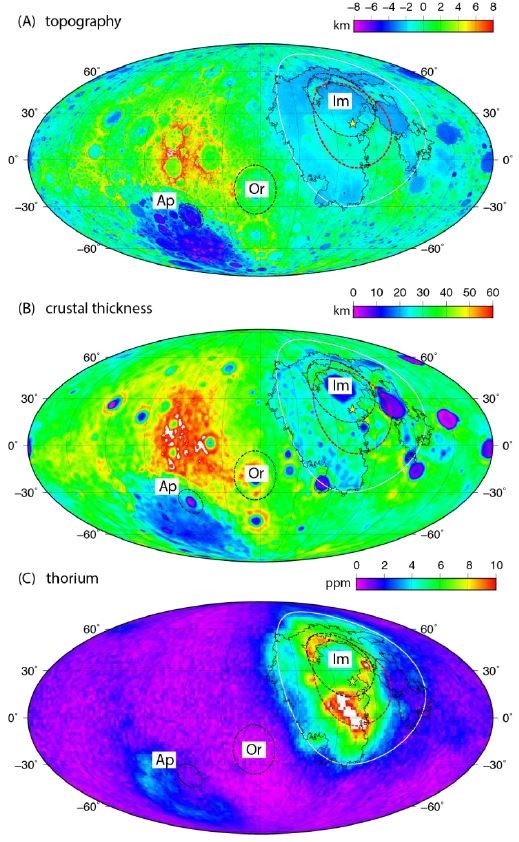
Image: The topographic (A), crustal thickness (B), and thorium distribution of the Moon show a dramatic difference between the nearside and farside. The star on the nearside represents the center of the proposed impact basin. The black dashed lines represent the boundary of Imbrium (Im), Orientale (Or), and Apollo (Ap) basin, respectively. Credit: JGR: Planets/Zhu et al. 2019/AGU.
My own interest in this paper is not so much the Moon itself as the fact that our abundant data on our satellite may help us understand the kind of asymmetries between hemispheres that can occur on large objects as the period of planet formation is drawing to its close. All that is part of learning about the origins of our own Solar System as well as conditions in the young systems we are now beginning to measure in circumstellar disks like the one at HD 163296 that I looked at on Friday (see HD 163296: Emerging Insights into Circumstellar Disks).
The paper is Zhu et al., “Are the Moon’s nearside?farside asymmetries the result of a giant impact?” Journal of Geophysicl Research: Planets 20 May 2019 (abstract).

HD 163296: Emerging Insights into Circumstellar Disks
We should be glad to run into the unexpected when doing research, because things we hadn’t foreseen often point to new understanding. That’s certainly the case with infant planetary systems as observed through the circumstellar disks of gas and dust surrounding young stars. ALMA (the Atacama Large Millimeter/submillimeter Array) has been central to the study of such targets. An array of 66 radio telescopes in Chile’s Atacama Desert, the facility works at millimeter and submillimeter wavelengths to provide detailed imaging of emerging systems.
Because it has been revealing a variety of small-scale structures within circumstellar disks, ALMA is giving us insights into planet formation as we observe gaps, rings and spiral arms and their interactions with young planets. This is where the unexpected comes in. For researchers looking at a 5 million year old star called HD 163296 are seeing an unusual amount of dust, more than 300 times the mass of the Earth, despite the detection of at least three proposed planets whose masses range between that of Jupiter and twice that of Uranus.
HD 163296 is a Herbig Ae/Be star, a pre-main-sequence object still embedded in a gas-dust envelope. The star has about twice the mass of the Sun, with a massive disk accounting for approximately one tenth of the Sun’s mass. The disk is about 500 AU wide, making it perhaps twice the outer boundary of our own Kuiper Belt. It’s noteworthy that the disk remains as abundant as it is given the age of the system and its production of at least three planets.
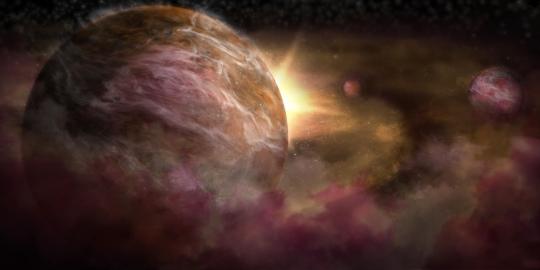
Image: Artist’s impression of protoplanets forming around a young star. Credit: NRAO / AUI / NSF / S. Dagnello.
The conventional model of dust distribution in this environment is migration from the outer regions of the disk inward because of coupling and friction with abundant gas, and the assumption has been that this migration would be stopped by the presence of massive planets. The hypothesized result: Dust piling up outside the orbits of the massive planets, while clearing out inside the orbit of the innermost planet as the dust migrates onto the star.
But the new ALMA observations, in tandem with the researchers’ dynamical simulations of this system and their application of a collisional model to test various outcomes, show a different result. The orbital regions inside the first planet, as well as between the first and second planet, have some of the highest concentrations of dust anywhere in the disk. The new work looks at this dust distribution in terms not only of interactions with gas and the new planets but also with what must be a large population of planetesimals, small objects that provide the building blocks of planet formation.
Diego Turrini is lead author of the study and a researcher at the Institute for Space Astrophysics and Planetary Science (IAPS) of the Italian National Institute of Astrophysics (INAF):
“From the study of the Solar System we know that mature circumstellar disks like HD 163296 are not composed only by gas and dust, but also contain an invisible population of small planetary objects similar to our asteroids and comets. We also know that the appearance of giant planets affects these planetesimals by causing in their orbital evolution a brief but intense spike of dynamical excitation that, while short from the point of view of the long life of a planetary system, can have a duration comparable to the life of circumstellar disks.”

Image: The circumstellar disk surrounding HD 163296 and the system of gaps and rings created by its young giant planets as recently imaged by ALMA (DSHARP Project). Credit: ALMA (ESO/NAOJ/NRAO), S. Dagnello.
Thus the dynamical simulations calculated to show these interactions and test their limits. What emerges is a regime of planetesimal collisions that remains relatively calm until the giant planets reach their ultimate masses. As the planets grow, more and more planetesimals are driven into eccentric, inclined orbits. At this point, planetesimal collisions become intense. We now have an explanation for the renewed dust in the system, and an orbital distribution of that dust markedly different from before, one where dust accumulates in the inner orbital region of the first planet and also forms a ring between the first and second planets.
These findings jibe with the ALMA observations, linking simulations to a living system. Thus Danai Polychroni, co-author of the study and at the time professor at the Universidad de Atacama and adjunct researcher at INAF-IAPS:
“The fast rate at which ALMA is providing new and more detailed data on HD 163296 allowed us to expand our study beyond its original scope. We noticed that many planetesimals are excited to supersonic velocities with respect to the surrounding gas of the disk and can create shocks waves that can heat both planetesimals and gas. While we could not yet model this process in detail, recent observations reported the unexpected presence of CO gas in regions characterized by temperatures where it should be frozen solid and of possible anomalies in the thermal structure of the disk. Both findings can in principle be explained thanks to the presence of these supersonic planetesimals and the shock waves they create.”

Image: The disk of icy planetesimals hidden in HD 163296’s circumstellar disk seen from above and the side. The young giant planets rapidly create a large population of exocomets acting as high-speed projectiles for the other bodies. Credit: D. Turrini (INAF-IAPS).
We’ve learned, then, that the formation of planets in a circumstellar disk can produce dynamical excitation leading to a resurgence in the ratio of dust to gas that halts the decay of the dust by creating second-generation dust grains through high-velocity collisions. This is useful stuff, for we’re observing more and more possible planets emerging in disks in which planetesimals should be widespread. The disk around HD 163296 may be showing us a stage of planet and system evolution that is common, and one we can now look for in a range of young systems.
From the paper:
The collisional production of second-generation dust in circumstellar disks hosting giant planets …likely represents a common evolutionary phase marking the transition from a circumstellar disk dominated by primordial dust to a debris disk dominated by second generation dust. Whether the amount of collisionally produced dust is high enough to produce observable signatures, like our results suggest being the case for HD 163296’s disk…depends on the characteristics of each specific system, first of all the masses of the giant planets and of the planetesimal disk.
The paper is Turrini et al., “Dust-to-gas ratio resurgence in circumstellar disks due to the formation of giant planets: the case of HD 163296,” Astrophysical Journal Vol. 877, No. 1 (23 May 2019). Abstract / Preprint.

Into the Neptunian Desert
A planet labeled NGTS-4b has turned up in a data space where astronomers had not expected it, the so-called ‘Neptunian desert.’ Three times Earth radius and about 20 percent smaller than Neptune, the world was discovered with data from the Next-Generation Transit Survey (NGTS), which specializes in transiting worlds around bright stars, by researchers from the University of Warwick. It turns out to be a scorcher, with temperatures in the range of 1,000 degrees Celsius.
NGTS-4b is 20 times as massive as the Earth, and its orbit takes it around its star, a K-dwarf 920 light years out, every 1.3 days. The planet is getting attention not so much because of what it is but where it is. Lead author Richard West (University of Warwick) comments:
“This planet must be tough – it is right in the zone where we expected Neptune-sized planets could not survive. It is truly remarkable that we found a transiting planet via a star dimming by less than 0.2% – this has never been done before by telescopes on the ground, and it was great to find after working on this project for a year. We are now scouring out data to see if we can see any more planets in the Neptune Desert – perhaps the desert is greener than was once thought.”
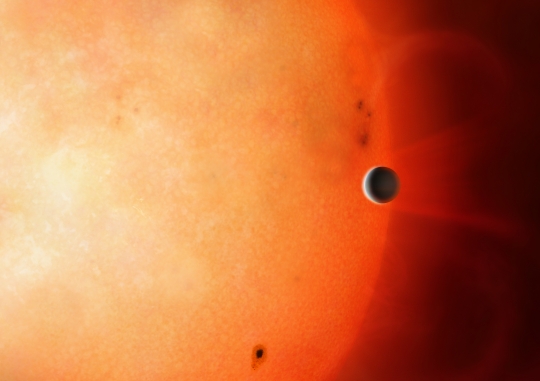
Image: An artist’s conception of exoplanet NGTS-4b. Credit: University of Warwick/Mark Garlick.
The paper on NGTS-4b has me thinking about all of our exoplanet detection methods in terms of their strengths and weaknesses, for there are some things that each of them can’t do well. Consider Jupiter-class worlds in orbits comparable to the Solar System’s largest planet. Depending on where the planet was in its orbit, an astronomer might look for a transit of such a world for years and never see it, even if it were the dominant planet in its system.
Even an Earth-sized planet in a habitable zone comparable to the Sun’s is going to take a year or so to complete its orbit, so we’d need several years to confirm it. When the exoplanet hunt began to take off in the energizing months and years after the discovery of 51 Pegasi b, we were finding ‘hot Jupiters’ in unexpectedly close orbits and more than a few of them. Here again observational bias was in play — we found these early on because radial velocity methods could detect these more easily than the tougher, smaller targets further out in the system.
But the Neptunian desert does not seem to be the result of observational bias. What we discover in looking at Kepler statistics is that there are few short-period Neptune-sized worlds, a ‘desert’ that the paper on this work defines as a lack of exoplanets with masses around 0.1 Jupiter mass and orbital periods less than 2-4 days. The reason this isn’t considered observational bias is that such planets should be easy to spot, and we’ve found many Neptunes with longer orbits from missions like Kepler and CoRoT. We may still find, however, that short-period Neptunes produce transits too shallow for most ground-based surveys to detect.
The issue of ‘deserts’ may well remind you of the better known ‘brown dwarf desert,’ which refers to the lack of such objects in orbits closer than 5 AU around solar mass stars. This desert turned up statistically at a time when numerous free-floating brown dwarfs were being found. Explanations include the possibility of brown dwarf migration into the primary star, but we’re a long way from fully understanding migration within a protoplanetary disk. Various formation models produce different outcomes as the investigation of the phenomenon continues.
Meanwhile, as the University of Warwick researchers note, the transit of NGTS-4b is the shallowest ever detected from the ground, giving us the promise of further such discoveries. From the paper:
The discovery of NGTS-4b is a breakthrough for ground-based photometry, the 0.13 ± 0.02 per?cent transit being the shallowest ever detected from a wide-field ground-based photometric survey. It allows us to begin to probe the Neptunian desert and find rare exoplanets that reside in this region of parameter space. In the near future, such key systems will allow us to place constraints on planet formation and evolution models and allow us to better understand the observed distribution of planets. Together with future planet detections by NGTS and TESS we will get a much clearer view on where the borders of the Neptunian desert are and how they depend on stellar parameters.
The scientists offer two possibilities for the survival of this planet in the Neptunian desert, and in particular for the persistence of its atmosphere in these hellish conditions. NGTS-4b may have an unusually high core mass, or it may have migrated in to its current close orbit, probably within the last one million years, so that its atmosphere would still be evaporating. The question would then be whether the ‘desert’ is elsewhere marked by a mechanism stopping such migration.
The paper is West et al., “NGTS-4b: A sub-Neptune transiting in the desert,” Monthly Notices of the Royal Astronomical Society, Volume 486, Issue 4 (July 2019), pp. 5094–5103 (abstract / full text).

Triton: Insights into an Icy Surface
Al Jackson reminds me in a morning email that today is the 100th anniversary of the Arthur Eddington expedition that demonstrated the validity of Einstein’s General Relativity. The bending of starlight could be observed by looking at the apparent position of stars in the vicinity of the Sun during a solar eclipse. Eddington’s team made the requisite observations at Principe, off the west coast of Africa, and the famous New York Times headline would result: “Lights All Askew in the Heavens . . . Einstein Theory Triumphs.”
Al also sent along a copy of the original paper in Philosophical Transactions of the Royal Society of London, where authorship is given as “F. W. Dyson, A. S. Eddington and C. Davidson.” This created an agreeable whimsy: I imagined the evidently ageless Freeman Dyson continually traveling through time to provide his insights at major achievements like this, but the reality is that this Dyson was Frank Dyson, then Britain’s Astronomer Royal.
Ron Cowen does a wonderful job on the Eddington eclipse expedition for Scientific American today, if you’d like to read more. And now on to today’s story.
Ices on Neptune’s Largest Moon
Triton has always intrigued me, and in most ways even more than Titan. When I was young, Triton was thought to be much larger than it actually is, and it had the imaginative advantage of being far more distant, so that we had another world almost as large as a planet, we thought, way out there in the farthest reaches of the Solar System. The fact that Triton’s orbit was retrograde also helped, an indication of its likely history as a captured Kuiper Belt object.
We learned a lot once Voyager made the journey, verifying the fact that even though Triton is Neptune’s largest moon, it’s still only about ? the size of our own Moon. We found temperatures near absolute zero and an atmosphere almost 70,000 times less dense than that of the Earth, one laden with nitrogen, methane and carbon monoxide, with a striking mix of terrains.
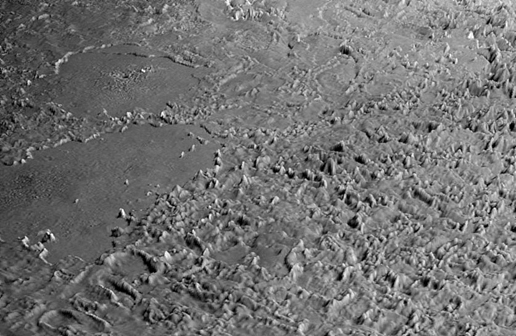
Image: This view of the volcanic plains of Neptune’s moon Triton was produced using topographic maps derived from images acquired by NASA’s Voyager spacecraft during its August 1989 flyby. Triton, Neptune’s largest moon, was the last solid object visited by the Voyager 2 spacecraft on its epic 10-year tour of the outer solar system. The rugged terrain in the foreground is Triton’s infamous cantaloupe terrain, most likely formed when the icy crust of Triton underwent wholesale overturn, forming large numbers of rising blobs of ice (diapirs). The numerous irregular mounds are a few hundred meters (several hundred feet) high and a few kilometers (several miles) across and formed when the top of the crust buckled during overturn. The large walled plains are of unknown origin, although the irregular pit in the center of the background walled plain may be volcanic in nature. These plains are approximately 150 meters (0.093 miles) deep and 200 to 250 kilometers (124 to 155 miles) across. Credit: NASA/JPL/Universities Space Research Association/Lunar & Planetary Institute.
Triton also offers a striking example of laboratory work leading to insights into distant places. A paper now in process at the Astronomical Journal looks at a specific wavelength of infrared light that is absorbed when carbon monoxide and nitrogen molecules vibrate in unison. Both absorb their own distinct wavelengths of infrared light, but the vibration of an icy mixture of the two produces a unique separate wavelength that the study has identified.
Now we turn to the 8-meter Gemini South Telescope in Chile, which the team used to confirm the same infrared signature on Triton, using a high resolution spectrograph called IGRINS (Immersion Grating Infrared Spectrometer). Stephen Tegler (Northern Arizona University), who led the study, gets across the satisfaction of closing the gap between analysis and observation:
“While the icy spectral fingerprint we uncovered was entirely reasonable, especially as this combination of ices can be created in the lab, pinpointing this specific wavelength of infrared light on another world is unprecedented.”
The work shows us a Triton where both carbon monoxide and nitrogen freeze as solid ices, but also are able to form an icy mixture that is revealed in the Gemini data. Voyager 2 observed dark streaks on the surface during its 1989 flyby, and we saw geysers at the moon’s south polar region. We may be looking at evidence of an internal ocean providing a source for the geyser material, or possibly heating of the thin layer of volatile surface ices by the Sun.

Image: Voyager 2 image of Triton showing the south polar region with dark streaks produced by geysers visible on the icy surface. Credit: NASA/JPL.
To go any further demands continued investigation, preferably with (one day) an orbiter or lander mission to Triton. For now, though, the fusion of lab work with existing data shows the continuing relevance of the one mission we did manage to fly by distant Neptune, and the ability of Earth-based instruments to build on our emerging understanding of its largest moon.
“Despite Triton’s distance from the Sun and the cold temperatures, the weak sunlight is enough to drive strong seasonal changes on Triton’s surface and atmosphere,” adds Henry Roe, Deputy Director of Gemini and a member of the research team. “This work demonstrates the power of combining laboratory studies with telescope observations to understand complex planetary processes in alien environments so different from what we encounter every day here on Earth.”
Seasonal variation on Triton is slow-moving given Neptune’s 165-year orbit, so that each season lasts about 40 years. Triton’s summer solstice occurred in 2000, meaning we are 20 years out before autumn begins. Patient data gathering will help us see how seasonal variations in the atmosphere and on the surface affect the mixture of ices to be found there. We also now know to look for the infrared signature of mixing ices on other small worlds in the Kuiper Belt.
The paper is Tegler et al., “A New Two-Molecule Combination Band as Diagnostic of Carbon Monoxide Diluted in Nitrogen Ice on Triton,” in press at the Astronomical Journal.

A Comet Family with Implications for Earth’s Water
‘Hyperactive’ comets tend to call attention to themselves. Take Comet Hartley 2 (103P/Hartley), which was visited by the EPOXI mission (formerly Deep Impact) in November of 2010. Three months of imaging and 117,000 images and spectra showed us just how much water and carbon dioxide the little comet was producing in the form of asymmetrical jets, a level of cometary activity that made the comet, in the words of one researcher, ‘skittish.’ It was, said EPOXI project manager Tim Larson at the time, “moving around the sky like a knuckleball.”
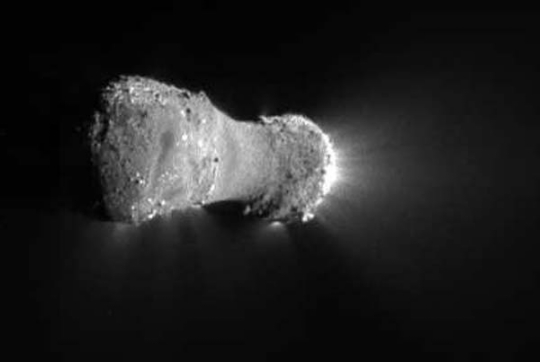
Image: Comet Hartley 2, in every sense of the term a moving target. Credit: NASA.
Nor is Hartley 2 alone. Scientists had a good look at comet 46P/Wirtanen from the SOFIA airborne observatory [Stratospheric Observatory for Infrared Astronomy] last December. Here again we see a pattern of hyperactivity, with a comet releasing more water than the surface area of the nucleus would seem to allow. The excess draws on an additional source of water vapor in these comets, ice-rich particles originally expelled from the nucleus that have undergone sublimation into the cometary atmosphere, or coma. Moreover, it’s water with a difference.
For if there is one topic that draws the attention of all of us interested in the early Solar System, it’s the question of where Earth’s water comes from. A standard model of the protosolar nebula has temperatures in the terrestrial planet zone too high for water ice to survive, which would mean that the Earth accreted dry, and present-day water would have been delivered later, by comets or asteroids. Other models of in situ production of Earth’s water are also in contention, so the field is far from won by comets, asteroids or other mechanisms.
One way to study the comet possibility is through isotopic ratios, where we have two forms of a chemical element with different mass. Thus deuterium, which is a heavier form of hydrogen, can be measured in the deuterium/hydrogen, or D/H ratio. Data from Oort Cloud comets have tended to run twice to three times the value of ocean water, making them an unlikely contributor to the early Earth. But we also have three hyperactive comets — 03P/Hartley, 45P/Honda-Mrkos-Pajdušáková and 46P/Wirtanen — with the same D/H ratio as Earth’s water. That would imply that such comets could indeed have delivered water to the Earth.
Thus the interest in 46P/Wirtanen shown by European researchers at the Paris Observatory and the Sorbonne, affiliated with the French National Center for Scientific Research, who are behind the recent observations. Their analysis of the D/H ratio in this comet and other comets with known ratios shows that “…a remarkable correlation is present between the D/H ratio and hyperactivity.”
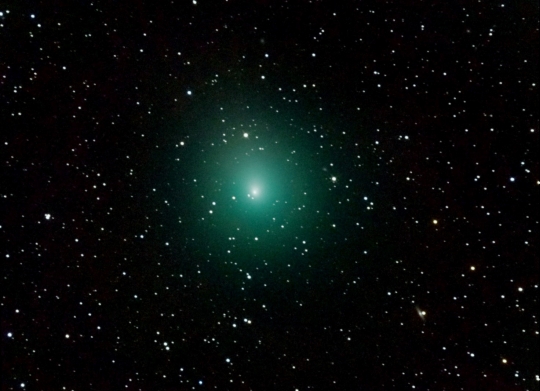
Image: The comet 46P/Wirtanen on January 3, 2019. Credit: © Nicolas Biver.
Although we seem to be seeing a clear distinction between Oort Cloud comets and Jupiter-family comets, we have to tread carefully. We also find that another Jupiter-family comet — 67P/Churyumov-Gerasimenko — has a D/H ratio three times Earth normal, while Oort cloud comet C/2014 Q2 has a ratio like Earth’s. So there’s no easy dividing line, leading the authors to add the suggestion “…that the same isotopic diversity is present in the two comet families.”
If that is the case, what makes cometary activity correlate in an inverse manner with the D/H ratio, so that the ratio in hyperactive comets decreases and approaches that of Earth water?
In a paper just published in Astronomy & Astrophysics, the researchers determined the active fraction — the fraction of nucleus surface area that it would take to produce the observed amount of water in the cometary atmospheres. They did this for all comets with a known D/H ratio. What they found was that the more a comet leans toward hyperactivity, the more its D/H ratio decreases and approaches that of the Earth. Out of this grows a hypothesis.
Hyperactive comets derive part of their water vapor from sublimation of icy grains expelled into their atmosphere, while non-hyperactive comets do not. These are processes that can show distinct D/H ratio signatures. Perhaps hyperactive comets provide a better glimpse of the ice within their nuclei, which turns out to be like that of Earth’s oceans. Those comets whose gas halo is produced only by surface ice do not show detectable ratios that are representative of what is available within the nuclei. If this is the case, then most comets have nuclei similar to terrestrial water, and comets can again be considered a major water source for Earth.
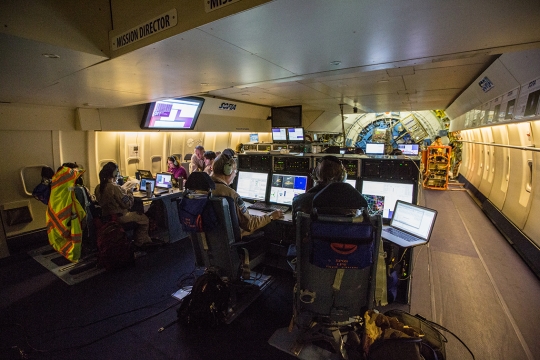
Image: Scientists at work aboard a Boeing 747 SOFIA Credit: © Nicolas Baker/IRAP/NASA/CNRS Photothèque.
We’re early in the game and other hypotheses are likewise in play. Hyperactive comets could belong to a population of ice-rich comets that formed just outside the snow line in the protoplanetary disk, indicating formation in a planetesimal. Or they could have formed in the outer regions of the solar nebula, which could also show a decrease in the D/H ratio.
But the most intriguing hypothesis remains the one suggesting that our measurements of D/H ratios are not representative of what is in the cometary nucleus. From the paper:
An alternative explanation is that the isotopic properties of water outgassed from the nucleus surface and icy grains may be different, owing to fractionation processes during the sublimation of water ice. The observed anti-correlation can be reproduced with two sources of water contributing to the measured water production rate and the active fraction: D-rich water molecules released from the nucleus and an additional source of D-poor water molecules from sublimating icy grains… Laboratory experiments on samples of pure ice show small deuterium fractionation effects… In experiments with water ice mixed with dust, the released water vapor is depleted in deuterium, explained by preferential adsorption of HDO on dust grains…
So a lot of ideas are in play, which means we need more accurate D/H measurements from both Oort comets and Jupiter-family comets. We need to find out whether hyperactive comets are simply showing us the norm; i.e., comets may all contain water very similar to what we have on Earth. And that would put comets back into play as a major contributor to Earth’s oceans.
“This is the first time we could relate the heavy-to-regular water ratio of all comets to a single factor,” notes Dominique Bockelée-Morvan, a scientist at the Paris Observatory and the French National Center for Scientific Research and second author of the paper. “We may need to rethink how we study comets because water released from the ice grains appears to be a better indicator of the overall water ratio than the water released from surface ice.”
The paper is Lis et al., “Terrestrial deuterium-to-hydrogen ratio in water in hyperactive comets,” Astronomy & Astrophysics Vol. 625, L5 (May 2019). Abstract / preprint.

